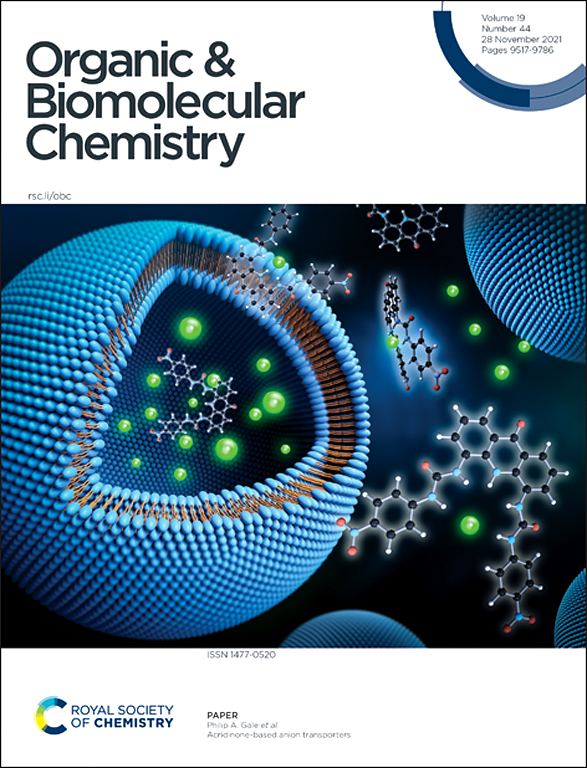揭示了氯胆碱-硫脲(1:1)DES作为α,β-不饱和羰基化合物合成嘧啶硫酮的绿色介质和试剂。
IF 2.7
3区 化学
Q1 CHEMISTRY, ORGANIC
引用次数: 0
摘要
人们越来越关注有机化合物的影响所带来的健康和环境问题,这促使人们对发展更绿色的有机化学技术进行广泛的研究。由于溶剂和催化剂是许多有机反应所必需的,绿色溶剂和催化剂可以解决这个问题。3,4-二氢嘧啶-2(1H)-硫酮(dhpm)是一类重要的生物分子。报道了几种合成dhpm的方法。然而,这些方法中的大多数都有一个或多个缺点,例如催化剂生产费力,使用昂贵的催化剂,反应条件恶劣,如反应时间长,温度高,碱性强,收率低。因此,本文报道了一种简单、有效、环保的方法,利用可生物降解、廉价、易获取的氯化胆碱:硫脲(CC: TU) 1:1的室温深共晶溶剂(DES),从α,β-不饱和羰基化合物合成4,6-二芳基-3,4-二氢嘧啶-2(1H)-硫酮。在优化的反应条件下,由结构和电子结构各异的α,β-不饱和羰基化合物合成的嘧啶硫酮产品收率在45-99%之间。CC: TU (1:1) DES首次用于合成方案,并发现它是一种增强介质和反应的反应物。希望本文将为开发新的合成二聚醚打开大门。它还将鼓励科学家探索使用CC: TU(1:1)作为涉及硫脲的几种有机转化的溶剂和反应物。本文章由计算机程序翻译,如有差异,请以英文原文为准。
Unveiling the choline chloride–thiourea (1 : 1) DES as a greener medium and reagent for pyrimidinethione synthesis from α,β-unsaturated carbonyl compounds†
Widespread studies on developing greener organic chemistry techniques were prompted by growing concerns about the health and environmental issues brought on by the effects of organic compounds. Since solvents and catalysts are necessary for many organic reactions, greener solvents and catalysts could remedy this problem. 3,4-Dihydropyrimidine-2(1H)-thiones (DHPMs) are an essential class of biomolecules. Several methods for synthesizing DHPMs have been reported. Nevertheless, most of these methods were linked to one or more disadvantages, such as laborious catalyst production, use of expensive catalysts, and severe reaction conditions like longer reaction times, higher temperatures and strong base, and reduced yields. Therefore, a simple, effective, and environmentally friendly protocol for the synthesis of 4,6-diaryl-3,4-dihydropyrimidine-2(1H)-thiones from α,β-unsaturated carbonyl compounds using the biodegradable, cheap, and easily accessible choline chloride : thiourea (CC : TU) 1 : 1 room temperature deep eutectic solvent (DES) is reported. The pyrimidinethione products were obtained from structurally and electronically diverse α,β-unsaturated carbonyl compounds in good to excellent (45–99%) yields under the optimized reaction conditions. The CC : TU (1 : 1) DES was used for the first time in a synthetic protocol, and it was found to be an augmenting medium and a reactant for the reaction. Hopefully, this paper will open doors to developing new DESs for synthesis. It will also encourage scientists to explore using CC : TU (1 : 1) as a solvent and reactant for several organic transformations involving thiourea.
求助全文
通过发布文献求助,成功后即可免费获取论文全文。
去求助
来源期刊

Organic & Biomolecular Chemistry
化学-有机化学
CiteScore
5.50
自引率
9.40%
发文量
1056
审稿时长
1.3 months
期刊介绍:
Organic & Biomolecular Chemistry is an international journal using integrated research in chemistry-organic chemistry. Founded in 2003 by the Royal Society of Chemistry, the journal is published in Semimonthly issues and has been indexed by SCIE, a leading international database. The journal focuses on the key research and cutting-edge progress in the field of chemistry-organic chemistry, publishes and reports the research results in this field in a timely manner, and is committed to becoming a window and platform for rapid academic exchanges among peers in this field. The journal's impact factor in 2023 is 2.9, and its CiteScore is 5.5.
 求助内容:
求助内容: 应助结果提醒方式:
应助结果提醒方式:


